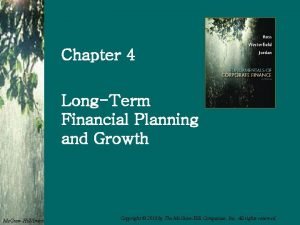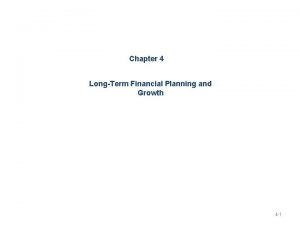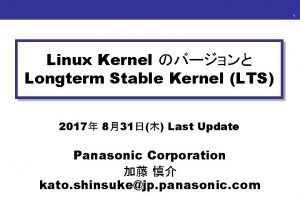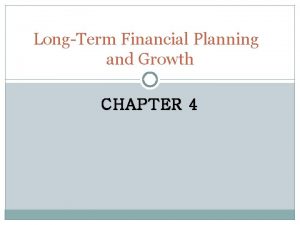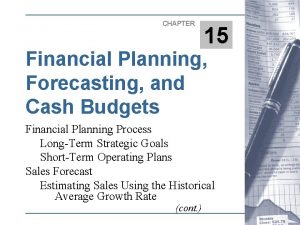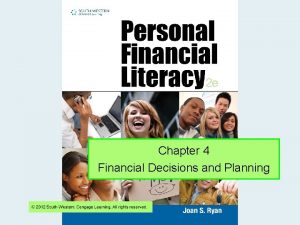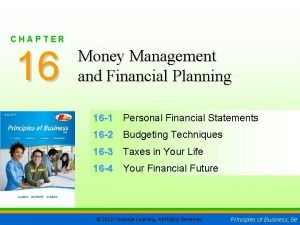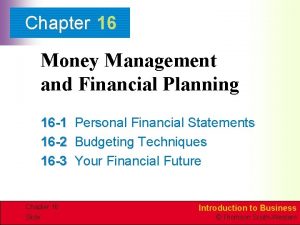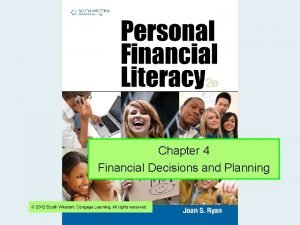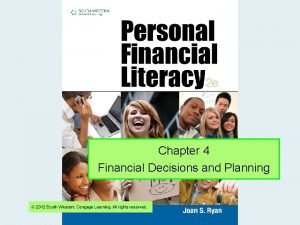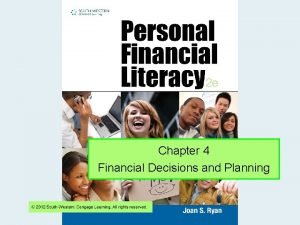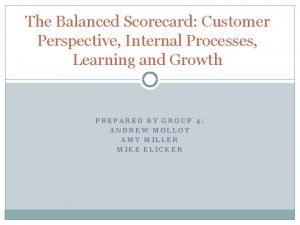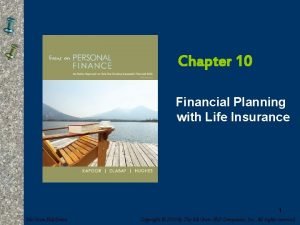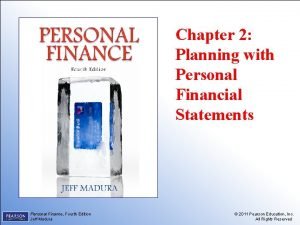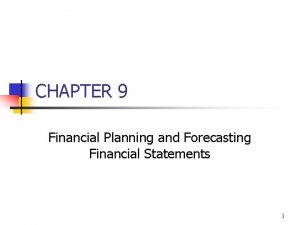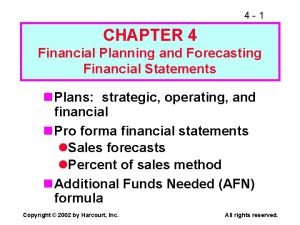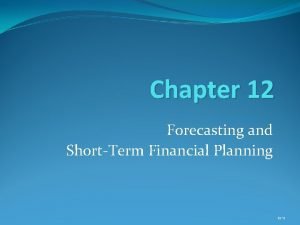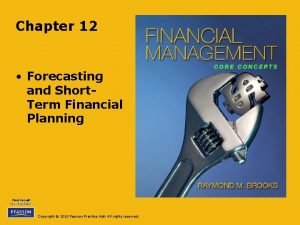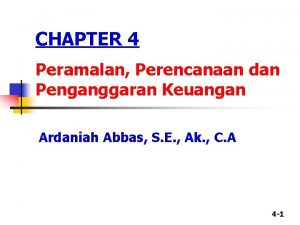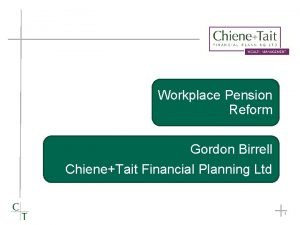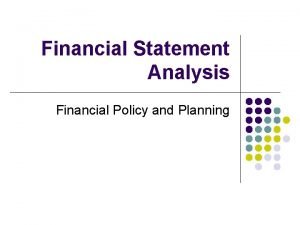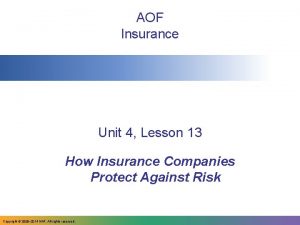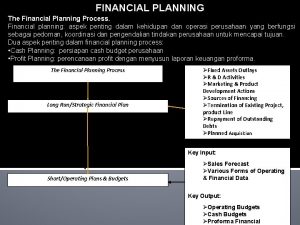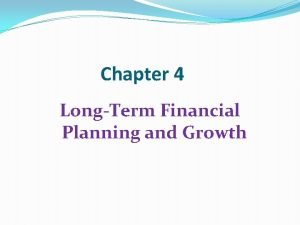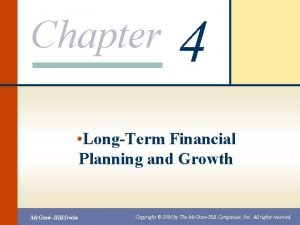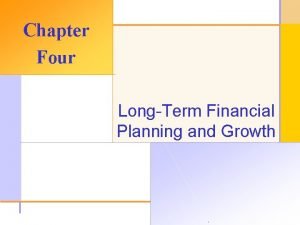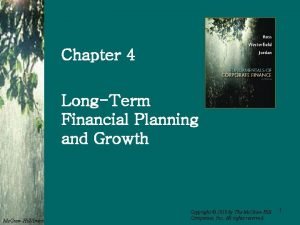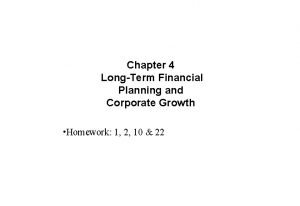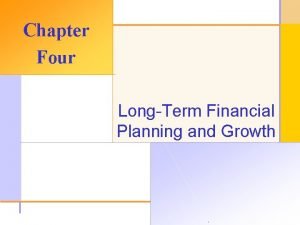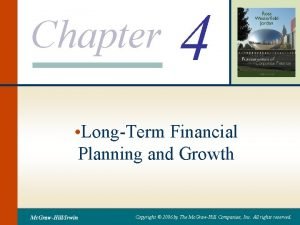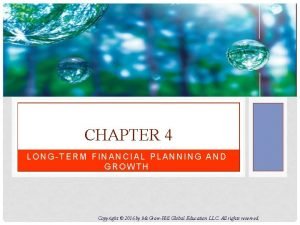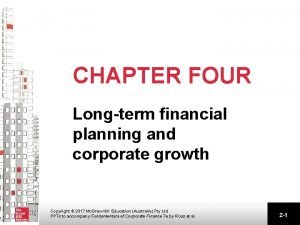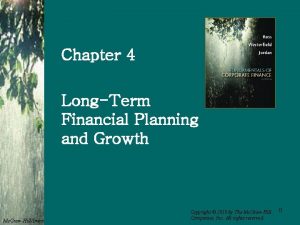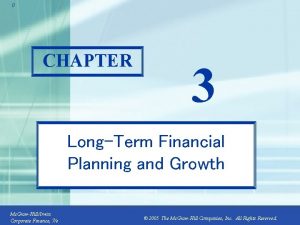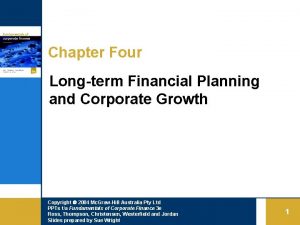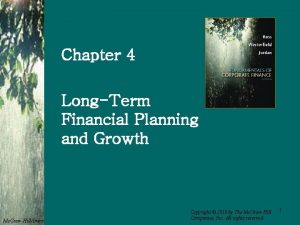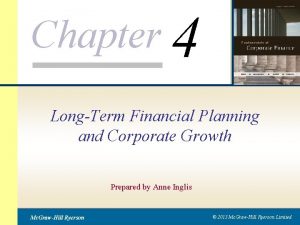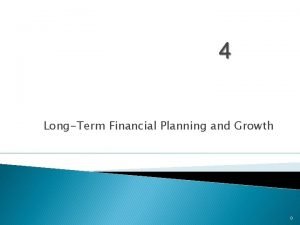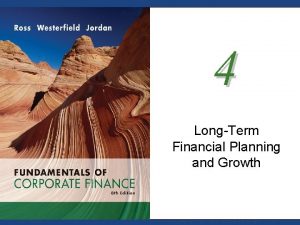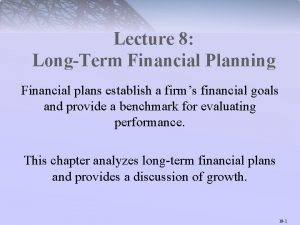Chapter 2 LongTerm Financial Planning and Growth Mc



































- Slides: 35

Chapter 2 • Long-Term Financial Planning and Growth Mc. Graw-Hill/Irwin Copyright © 2006 by The Mc. Graw-Hill Companies, Inc. All rights reserved.

Chapter 01– Index of Sample Problems • • Slide # 02 - 05 Slide # 06 - 08 Slide # 09 - 13 Slide # 14 - 16 Slide # 17 - 23 Slide # 24 - 27 Slide # 28 - 29 Slide # 30 - 34 Plowback and dividend payout ratios Constant growth planning Percentage of sales planning External financing need Pro forma with external financing Capacity level Internal growth Sustainable growth

2: Plowback and dividend payout ratios Your company has net income of $1, 600 for the year. You paid out $400 in dividends to your stockholders. What is the dividend payout ratio? What is the plowback ratio? What is the dollar increase in retained earnings?

3: Plowback and dividend payout ratios Your company has net income of $1, 600 for the year. You paid out $400 in dividends to your stockholders.

4: Plowback and dividend payout ratios This year your company expects net income of $2, 800. You now adhere to a 60% plowback ratio. What is the expected dollar increase in retained earnings? How much do you expect to pay in dividends? What is the dividend payout ratio?

5: Plowback and dividend payout ratios This year your company expects net income of $2, 800. You now adhere to a 60% plowback ratio.

6: Constant growth planning You expect your sales, costs and assets to grow by 10% next year. You will not pay any dividends. Can you complete the pro forma statement? Round all amounts to whole dollars. Income Statement Current Projected Sales $800 $_______ Costs $700 $_______ Taxable income $100 $_______ Taxes (34%) $ 34 $_______ Net income $ 66 $_______ Balance Sheet Assets Current $400 Projected $_______ Total $400 $_______ Debt Equity Total Current $150 $250 $400 Projected $_______

7: Constant growth planning The computations are shown on the next slide. Income Statement Current Projected Sales $800 $880 Costs $700 $770 Taxable income $100 $110 Taxes (34%) $ 34 $ 37 Net income $ 66 $ 73 Balance Sheet Assets Current $400 Projected $440 Total $400 $440 Debt Equity Total Current $150 $250 $400 Projected $117 $323 $440

8: Constant growth planning Step 1 Step 3 Step 2 Step 4

9: Percentage of sales planning The assets and current liabilities of Jennings, Inc. vary in direct proportion to the increase in sales. The current sales are $2, 000 and you expect them to increase by 20% next year. Net income is projected at 5% of sales. The firm is not planning on issuing any more common stock nor paying any dividends. Using this information, can you compile the pro forma balance sheet shown on the next slide?

10: Percentage of sales planning Current % of sales Projected Cash Accounts receivable Inventory Fixed assets Total assets $ 120 $ 500 $ 840 $2, 600 $4, 060 _____% _____% $_______ $_______ Accounts payable Long-term debt Common stock and paid in surplus Retained earnings Total liabilities and equity $ 600 $ 700 $1, 000 $1, 760 $4, 060 _____% _____% $_______ $_______ Refer to the prior slide for information pertaining to this problem. Enter n/a where the % of sales does not apply.

11: Percentage of sales planning Current % of sales Projected Cash Accounts receivable Inventory Fixed assets Total assets $ 120 $ 500 $ 840 $2, 600 $4, 060 6% 25% 42% 130% 203% $ 144 $ 600 $1, 008 $3, 120 $4, 872 Accounts payable Long-term debt Common stock and paid in surplus Retained earnings Total liabilities and equity $ 600 $ 700 $1, 000 $1, 760 $4, 060 30% n/a n/a $ 720 $1, 272 $1, 000 $1, 880 $4, 872 See the next slide for the computations

12: Percentage of sales planning Step 1 Computations continued on next slide Step 2

13: Percentage of sales planning Step 3 Step 4 Total liabilities and owners’ equity Accounts payable Common stock and paid in surplus Retained earnings Long-term debt $4, 872 -$ 720 -$1, 000 -$1, 880 $1, 272

14: External financing need You project your sales will increase by $3, 000 next year. Net income is 10% of sales and accounts payable is 25% of sales. The capital intensity ratio is 2. 5. No dividends are anticipated. How much external financing is needed to fund this growth? Try to solve this problem without looking at the hints on the next slide.

15: External financing need You project your sales will increase by $3, 000 next year. Net income is 10% of sales and accounts payable is 25% of sales. The capital intensity ratio is 2. 5. No dividends are anticipated. How much external financing is needed to fund this growth? Hints: Step 1: Compute the increase in total assets Step 2: Compute the increase in accounts payable Step 3: Compute the increase in retained earnings Step 4: Compute the additional long-term debt and equity financing that is needed

16: External financing need Step 1 Step 3 Step 4 Step 2

17: Pro forma with external financing Your firm currently has long-term debt of $4, 400, common stock and paid in surplus of $10, 000 and retained earnings of $4, 600. The capital intensity ratio is 2. 2 and the tax rate is 35%. Costs are 72% of sales and accounts payable are 30% of sales. Sales currently are $10, 000 and are expected to increase by 10% next year. The dividend payout ratio is 20%. Long-term debt will be used to fund 40% of the external funding need. Given this information, can you complete the pro forma financial statements on the next slide?

18: Pro forma with external financing Round all amounts to whole dollars. Pro forma Income Statement Sales Costs Taxable income Taxes (35%) Net Income Assets Total $______ $______ Pro forma Balance Sheet $______ Accounts payable Long-term debt Common stock Retained earnings $______ Total $______ $______

19: Pro forma with external financing The computations are shown on the next four slides. Pro forma Income Statement Sales Costs Taxable income Taxes (35%) Net Income Assets Total $11, 000 $ 7, 920 $ 3, 080 $ 1, 078 $ 2, 002 Pro forma Balance Sheet $24, 200 Accounts payable Long-term debt Common stock _______ Retained earnings $24, 200 Total $ 3, 300 $ 4, 519 $10, 179 $ 6, 202 $24, 200

20: Pro forma with external financing

21: Pro forma with external financing

22: Pro forma with external financing Total liabilities and owners’ equity Accounts payable Retained earnings Current long-term debt Current common stock External financing need $24, 200 -$ 3, 300 -$ 6, 202 -$ 4, 400 -$10, 000 $ 298

23: Pro forma with external financing

24: Capacity level Your firm has fixed assets of $28, 000 and is operating at 80% of capacity. Current sales are $18, 000. What is the full-capacity sales level? What is the capital intensity ratio at the full-capacity sales level?

25: Capacity level Your firm has fixed assets of $28, 000 and is operating at 80% of capacity. Current sales are $18, 000.

26: Capacity level Your firm has projected sales of $1, 600. The capital intensity ratio at the full-capacity sales level of $1, 900 is 1. 20. Ignoring the capacity level, you have projected net fixed assets at $2, 100 and the external financing need at $1, 000. What is the external financing need if the capacity level is considered?

27: Capacity level Your firm has projected sales of $1, 600. The capital intensity ratio at the full-capacity sales level of $1, 900 is 1. 20. Ignoring the capacity level, you have projected net fixed assets at $2, 100 and the external financing need at $1, 000. What is the external financing need if the capacity level is considered?

28: Internal growth Your firm has net income of $6, 000 and total assets of $30, 000. The dividend payout ratio is 40%. What is the internal growth rate?

29: Internal growth Your firm has net income of $6, 000 and total assets of $30, 000. The dividend payout ratio is 40%. What is the internal growth rate?

30: Sustainable growth A firm has net income of $2, 000 and pays $400 in dividends. Total equity is $8, 000. What is the sustainable growth rate?

31: Sustainable growth A firm has net income of $2, 000 and pays $400 in dividends. Total equity is $8, 000. What is the sustainable growth rate? Step 3 Step 1 Step 2 4

32: Sustainable growth Your firm has a 10% net profit margin and a dividend payout ratio of 25%. The debt-equity ratio is 40% and the total asset turnover rate is 2. What is the sustainable rate of growth?

33: Sustainable growth Your firm has a 10% net profit margin and a dividend payout ratio of 25%. The debt-equity ratio is 40% and the total asset turnover rate is 2. What is the sustainable rate of growth? Hints: Step 1. Find the equity multiplier using the debt-equity ratio Step 2. Compute the ROE using the Du. Pont formula Step 3. Find the plowback ratio using the dividend payout ratio Step 4. Compute the sustainable growth rate

34: Sustainable growth Your firm has a 10% net profit margin and a dividend payout ratio of 25%. The debt-equity ratio is 40% and the total asset turnover rate is 2. Step 1 Step 2 Step 3 Step 4
 Long term financial planning and growth chapter 4
Long term financial planning and growth chapter 4 Sustainable growth equation
Sustainable growth equation Lts stable
Lts stable York will end longterm solitary jails
York will end longterm solitary jails Long term financial planning and growth
Long term financial planning and growth Chapter 15 financial forecasting for strategic growth
Chapter 15 financial forecasting for strategic growth Chapter 4 financial decisions and planning
Chapter 4 financial decisions and planning Chapter 4 financial decisions and planning
Chapter 4 financial decisions and planning Chapter 16 money management and financial planning
Chapter 16 money management and financial planning What are some characteristics of a wise money manager
What are some characteristics of a wise money manager Chapter 4 financial decisions and planning
Chapter 4 financial decisions and planning Chapter 4 financial decisions and planning
Chapter 4 financial decisions and planning Chapter 4 financial decisions and planning
Chapter 4 financial decisions and planning Growth analysis
Growth analysis Root hair structure
Root hair structure Primary growth and secondary growth in plants
Primary growth and secondary growth in plants Chapter 35 plant structure growth and development
Chapter 35 plant structure growth and development Internal process perspective
Internal process perspective Chapter 10 financial planning with life insurance
Chapter 10 financial planning with life insurance Chapter 2 personal financial planning answers
Chapter 2 personal financial planning answers Growthchain
Growthchain Geometric growth population
Geometric growth population Neoclassical growth theory vs. endogenous growth theory
Neoclassical growth theory vs. endogenous growth theory Organic growth vs inorganic growth
Organic growth vs inorganic growth Financial and non financial motivation
Financial and non financial motivation Financial planning and forecasting
Financial planning and forecasting Financial planning and forecasting
Financial planning and forecasting Short term financial planning process
Short term financial planning process Financial planning and forecasting problems with solutions
Financial planning and forecasting problems with solutions Financial analysis planning and forecasting
Financial analysis planning and forecasting Peramalan perencanaan dan penganggaran keuangan
Peramalan perencanaan dan penganggaran keuangan Long term and short term financial planning
Long term and short term financial planning Chiene and tait financial planning
Chiene and tait financial planning Financial statement analysis and planning
Financial statement analysis and planning Unit 2 lesson 3 health insurance and financial planning
Unit 2 lesson 3 health insurance and financial planning Unit 2 lesson 3 health insurance and financial planning
Unit 2 lesson 3 health insurance and financial planning
